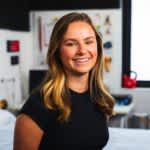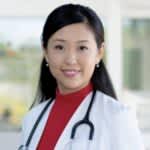When you buy through our links, we may earn a commission. Products or services may be offered by an affiliated entity. Learn more.
Back sleeping is the second most common sleeping position behind side sleeping. Its main benefit is that when you’re on your back, your body is naturally aligned over your spine. Maintaining this alignment is key for back sleepers, so your ideal mattress needs to support the hips and shoulders without putting too much pressure on them. Thus, an even sleep surface with some conforming but no sagging is usually the best bed for back sleepers.
- The Luxury Firm WinkBed is our top pick for back sleepers. It has the right amount of firmness to support a neutral spine along with tailored cushioning for the lower back.
- In this guide, we’ll try to simplify the shopping process by sharing our top picks for back sleepers and explaining criteria that can affect a back sleeper’s comfort.
- Looking for quick recommendations? Watch 1-minute video reviews of our favorite mattresses for back sleepers.
Our Top Picks
-
Best Mattress Overall – Luxury Firm WinkBed
View Details
-
Most Comfortable Mattress – Helix Dusk Luxe
View Details
-
Best Value Mattress – Nectar Adjustable Bundle
View Details
-
Best Luxury Mattress – Saatva Classic
View Details
-
Best Cooling Mattress – Brooklyn Bedding Aurora Luxe
View Details
-
Best Mattress for Couples – Bear Elite Hybrid
View Details
-
Best Firm Mattress – Plank Firm Luxe
View Details
-
Best Organic Mattress – Birch Mattress
View Details
Swipe for more
Best Mattress Overall
Luxury Firm WinkBed
9.5 /10
Test Lab Score
Get $300 off all mattresses at Winkbeds
Get $300 off all mattresses at Winkbeds
The WinkBed is a well-built mattress that ticks a lot of boxes for back sleepers. The hybrid design provides even spinal support, with pocketed coils that flex proportionally to support your body weight. The bed also includes extra padding under the lower back, which can be prone to pressure buildup when back sleeping.
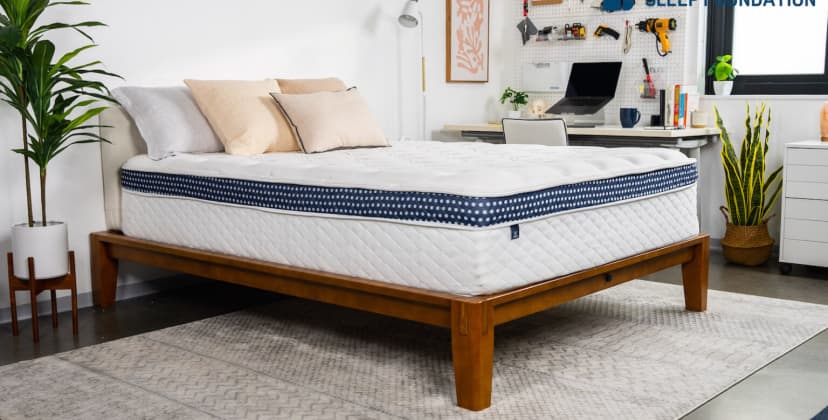

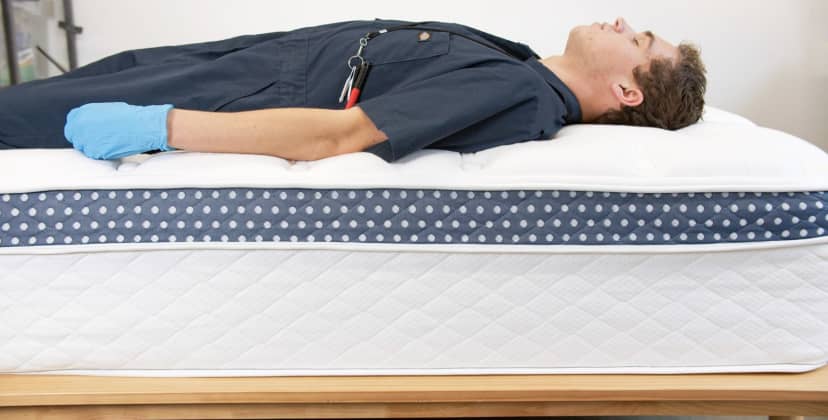

Credit: Sleep Foundation Test Lab
Price
$2,570
Mattress Type
Innerspring
Firmness Options
Medium Firm (6)
Trial Period
120 nights (30 night requirement)
At a Glance
- Who It’s Best For: Side and back sleepers, as well as hot sleepers or couples.
- Feel: Medium firm (6) with a lofty feel that cushions without letting sleepers sink in too far.
- What It’s Made Of: Tencel cover and a Euro-top with two layers of quilted gel polyfoam. Extra foam pad in the middle third of the bed, a third layer of gel-infused polyfoam, and a pocketed coil support core with reinforced edges and firmer coils in key areas.
- What We Don’t Like: Requires deep pocket sheets. Some motion transfer.
Scoring & Reviews
The following ratings show how suitable this mattress is for different sleeping positions and sleeper weights. These scores are determined by how well the mattress supports and relieves pressure for each sleeper type.
We performed a meta-analysis on 8573 validated customer reviews of the Winkbed. This is what people who bought the mattress had to say:- Quality of Materials: The mattress is frequently described as well-made, with durable materials that contribute to a good night’s sleep.
- Cooling Features: Some reviewers mention that the mattress does a good job of regulating temperature, providing a cooler sleep experience.
- Edge Support: While generally satisfied with the support, a few reviewers note that edge support could be better.
- Comfort and Support: Many reviewers praise the mattress for its comfort and support, often mentioning relief from back pain and improved sleep quality.
- Firmness Options: Customers appreciate the variety of firmness options available, finding the right balance for their personal preferences.
- Value for Money: Many users feel the mattress is worth the investment, offering good value for the quality and comfort provided.
- Made in the USA: Buyers are pleased that the mattresses are made in the USA, supporting domestic manufacturing.
Most Comfortable Mattress
Helix Dusk Luxe
9.7 /10
Test Lab Score
25% off sitewide with code WKFLSH25
25% off sitewide with code WKFLSH25
Helix makes a range of mattresses tailored to different sleeping positions. The Dusk Luxe offers moderately contouring foams that relieve pressure without allowing excessive sagging when back or stomach sleeping. This mattress also ranks well on motion isolation and breathability, and the edges hold up well when sleeping near the edge of the bed. Helix offers an optional upgrade to a foam layer with denser foam in the lumbar area.
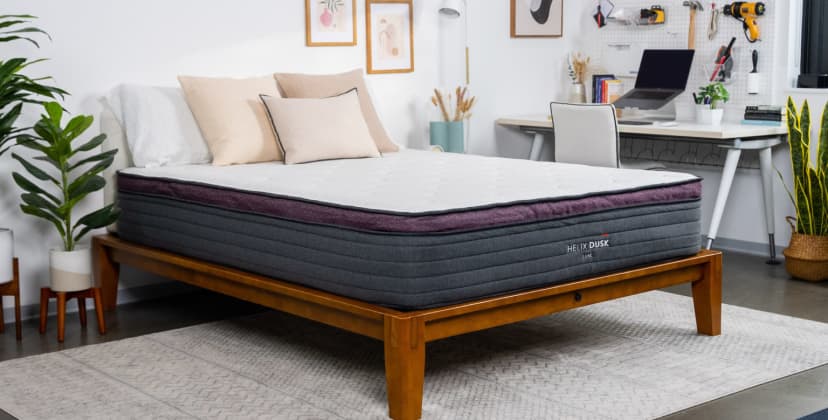
Credit: Sleep Foundation Test Lab
Price
$1,899
Mattress Type
Hybrid
Firmness Options
Medium Firm (6)
Trial Period
120 nights (30-night requirement)
At a Glance
- Who It’s Best For: Back, side, and stomach sleepers.
- Feel: Medium firm (6). Responsive foams keep the spine aligned and prevent the feeling of being stuck in the bed. The memory foam layer contours to relieve pressure points.
- What It’s Made Of: Quilted Tencel cover and three layers of polyfoam and memory foam. The support core is built pocketed coils, featuring targeted lumbar support and perimeter reinforcement.
- What We Don’t Like: Slightly too thick for a standard fitted sheet. May lack support for people over 230 pounds.
Scoring & Reviews
The following ratings show how suitable this mattress is for different sleeping positions and sleeper weights. These scores are determined by how well the mattress supports and relieves pressure for each sleeper type.
We performed a meta-analysis on 1230 validated customer reviews of the Helix Dusk Luxe. This is what people who bought the mattress had to say:- Comfort Level: Many users find the Helix Dusk Luxe mattress to be extremely comfortable, offering a good balance of support and softness, which helps in reducing back and hip pain.
- Pain Relief: Users have reported significant relief from back, hip, and neck pain, attributing this to the supportive nature of the mattress.
- Durability Concerns: Some reviewers have expressed concerns about the mattress’s longevity, noting issues such as sagging and loss of support over relatively short periods.
- Edge Support: Positive comments are made about the edge support of the mattress, allowing users to utilize the entire surface without feeling like they are going to roll off.
- Cooling Features: The mattress is often praised for its cooling features, helping sleepers maintain a comfortable temperature throughout the night.
- Customer Service: There are varying experiences with customer service; some report positive and helpful interactions, while others find it difficult to resolve issues through customer support.
Best Value Mattress
Nectar Adjustable Bundle
8.5 /10
Test Lab Score
Save up to 50% on mattresses + 15% off regular prices
Save up to 50% on mattresses + 15% off regular prices
If you’re looking to revamp your entire sleep setup, the Nectar Adjustable Bundle may be for you. This package deal includes not just the mattress, but also the bedding and an adjustable bed frame with features such as a zero-gravity position and a massage function. You can choose from among Nectar’s line of mattresses, although many shoppers will be happy with the flagship Nectar all-foam model

Price
$1,398
Sizes
Twin XL, Full, Queen, King, Split King
At a Glance
- Who It’s Best For: People with chronic pain and obstructive sleep apnea, couples, and side and back sleepers under 230 pounds.
- Feel: Medium firm (6). The top layers hug your body, while the slightly more responsive layers underneath keep you from sinking too far in.
- What It’s Made Of: All-foam model with 3 inches of gel-infused memory foam, 2 inches of transitional polyfoam, and a 7-inch polyfoam support core. Nectar also makes hybrid models and specialty models with extra features.
- What We Don’t Like: Expensive. Not available in twin or California King. Surface may limit movement, trap heat, and allow excessive sinkage for stomach sleepers.
Scoring Breakdown
The following ratings show how suitable this mattress is for different sleeping positions and sleeper weights. These scores are determined by how well the mattress supports and relieves pressure for each sleeper type.
Best Luxury Mattress
Saatva Classic
9.5 /10
Test Lab Score
$300 off orders of $1,000 or more
$300 off orders of $1,000 or more
Available in three firmness levels, the Saatva Classic’s dual-coil design and targeted lumbar support provide a supportive, responsive surface for back sleepers. The mattress is available in an 11.5-inch or a 14.5-inch profile, both of which perform the same but may have advantages depending on the height of your bed frame and other considerations. Saatva delivers every mattress with complimentary White Glove delivery.

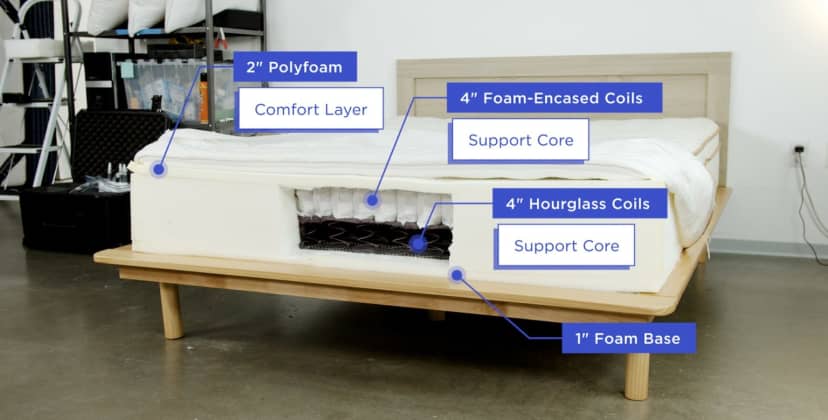
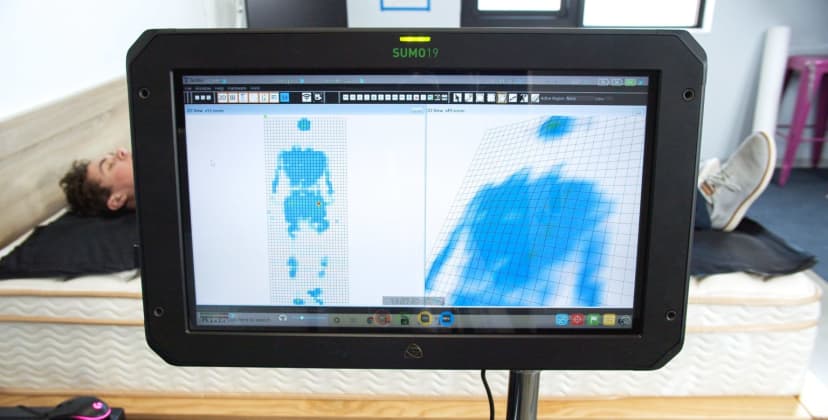

Credit: Sleep Foundation Test Lab
Price
$1,795
Mattress Type
Innerspring
Firmness Options
Soft (3), Medium Firm (6), Firm (8)
Trial Period
365 Nights ($99 Return Fee)
At a Glance
- Who It’s Best For: Back sleepers weighing at least 130 pounds (Firm and Luxury Firm).
- Feel: Soft (3), medium firm (6), or firm (8). Breathable and highly responsive, almost bouncy sleep surface.
- What It’s Made Of
- Euro-top design with 3 inches of padding. Memory foam pad in the middle third, as well as an active spinal wire. Two layers of coils, with added reinforcement around the edges of the bed. Organic cotton cover with a natural thistle flame barrier.
- What We Don’t Like: Expensive. Return fee of $99.
Scoring & Reviews
The following ratings show how suitable this mattress is for different sleeping positions and sleeper weights. These scores are determined by how well the mattress supports and relieves pressure for each sleeper type.
We performed a meta-analysis on 3308 validated customer reviews of the Saatva Classic. This is what people who bought the mattress had to say:- Delivery Service: Positive feedback on the delivery process is common, with customers highlighting the professionalism and efficiency of the delivery teams. The white glove delivery service, including old mattress removal, is frequently praised.
- Comfort and Firmness: Customers appreciate the customizable firmness options, with Plush Soft, Luxury Firm, and Firm levels catering to diverse preferences.
- Durability: Long-term users report that the mattress maintains its comfort and support over the years, indicating good durability and quality construction.
- Material Quality: Customers appreciate the safe and high-quality materials used in the mattress, such as the absence of harmful chemicals and the use of organic cotton.
- Temperature Regulation: Some reviewers specifically mention sleeping cooler on the Saatva Classic, highlighting its temperature regulation features that contribute to a more comfortable sleep.
- Adjustability and Customization: The ability to customize the mattress for personal needs, like the split king option with different firmness levels, is a significant plus for many customers.
Best Cooling Mattress
Brooklyn Bedding Aurora Luxe
9.2 /10
Test Lab Score
25% off sitewide with code: WINTER25
25% off sitewide with code: WINTER25
Open-cell foams, gel and copper infusions, phase change fibers, and pocketed coils collaborate to promote airflow and reduce heat retention in the Brooklyn Bedding Aurora Luxe. This mattress is sold in three firmness options, all of which offer strong edge support to quash feelings of instability when sleeping near the edge of the bed. Our testers also found it relatively easy to switch positions despite the thick foam comfort system.
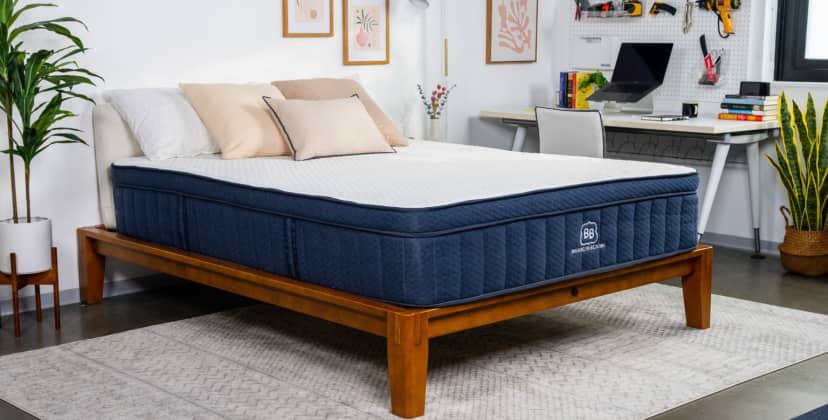
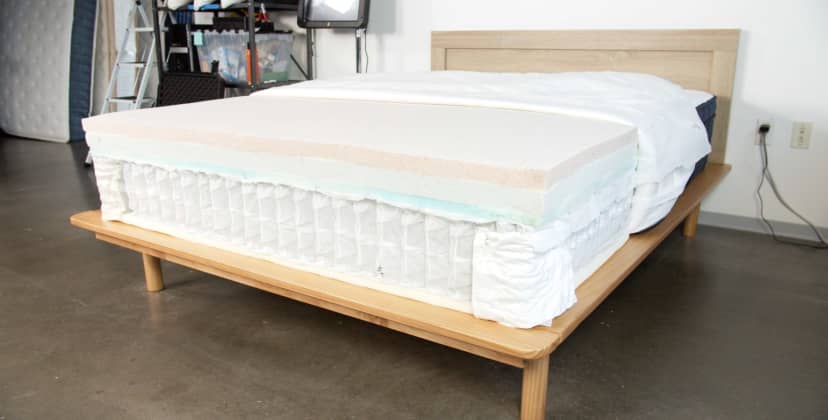

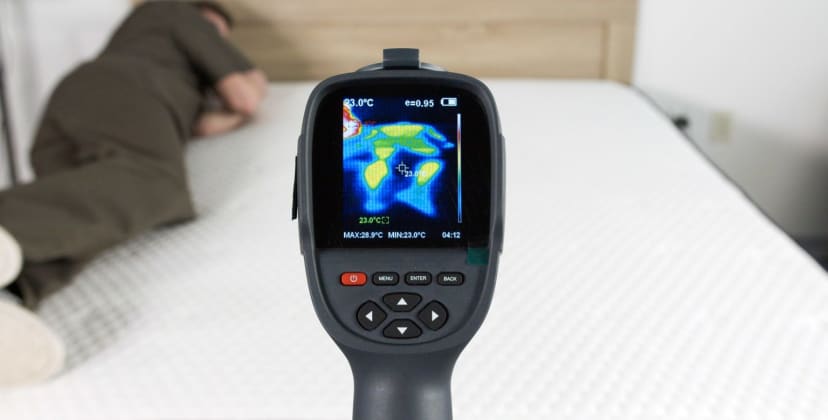
Credit: Sleep Foundation Test Lab
Price
$1,586
Mattress Type
Hybrid
Firmness Options
Medium Soft (4), Medium Firm (6), Firm (7)
Trial Period
120 nights (30-night requirement)
At a Glance
- Who It’s Best For: Back sleepers under 130 pounds (softest model), between 130 and 230 pounds (medium firm model), and over 230 pounds (firm).
- Feel: Medium soft (4), medium firm (6), or firm (7) versions. The medium soft hugs the sleeper quite closely, while the medium firm and firm models provide more subtle contouring.
- What It’s Made Of: GlacioTex cover with phase change material. The foam comfort system uses open-cell foams, as well as gel and copper infusions. Coil support core reinforced in the lumbar area and along the perimeter. Optional 2-inch pillow-top.
- What We Don’t Like: Firm model allows significant motion transfer. Return fee of $99.
Scoring & Reviews
The following ratings show how suitable this mattress is for different sleeping positions and sleeper weights. These scores are determined by how well the mattress supports and relieves pressure for each sleeper type.
We performed a meta-analysis on 3474 validated customer reviews of the Brooklyn Bedding Aurora Luxe. This is what people who bought the mattress had to say:- Height and Thickness: Many reviewers mention the mattress being taller or thicker than anticipated, requiring adjustments like new bed sheets.
- Comfort and Support: Consistent mentions of the mattress providing good support and comfort, suitable for various sleeping positions and body types.
- Cooling Features: A significant number of people appreciate the cooling aspect of the mattress, which is particularly beneficial for hot sleepers.
- Firmness Levels: Some reviewers note discrepancies in the expected versus actual firmness levels, with some finding the mattresses softer than anticipated.
- Edge Support: Mixed reviews on edge support, with some finding it adequate and others noting it could be improved. We found it to be relatively average for a hybrid
- Material Quality: Reviews often mention the high quality of materials, though some note issues with sheets slipping off due to the sleekness of the mattress cover.
- Smell and Off-Gassing: Some mention a noticeable smell upon unpacking that dissipates over time.
Best Mattress for Spinal Alignment
Nolah Evolution 15
9.2 /10
Test Lab Score
35% off sitewide + extra $100 off with code: SF100
35% off sitewide + extra $100 off with code: SF100
The Nolah Evolution 15 features zoning in both the comfort and support systems to help keep your spine on an even plane. The mattress is sold in three firmness options to accommodate back sleepers with different body types. The firmest model also supplies very good temperature control and edge support, for those who appreciate a sturdy surface when getting in and out of bed.

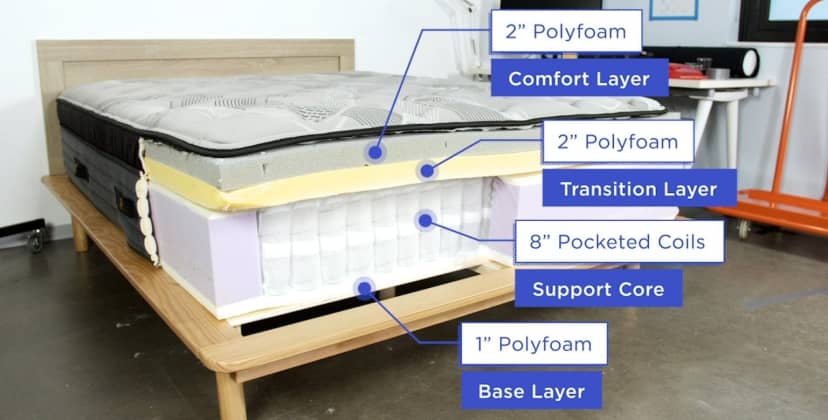
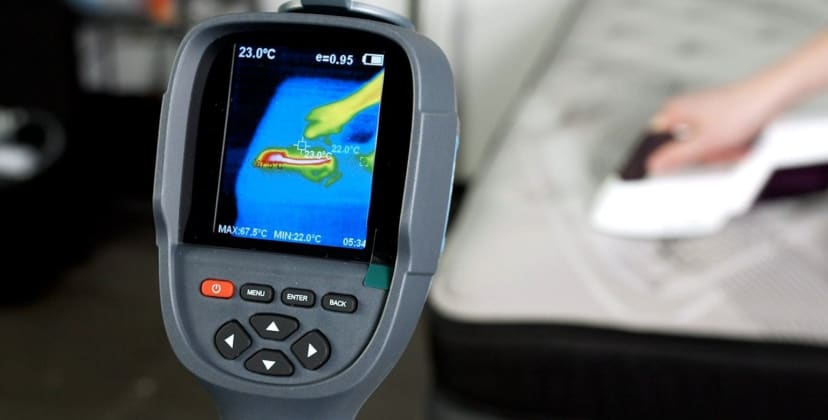
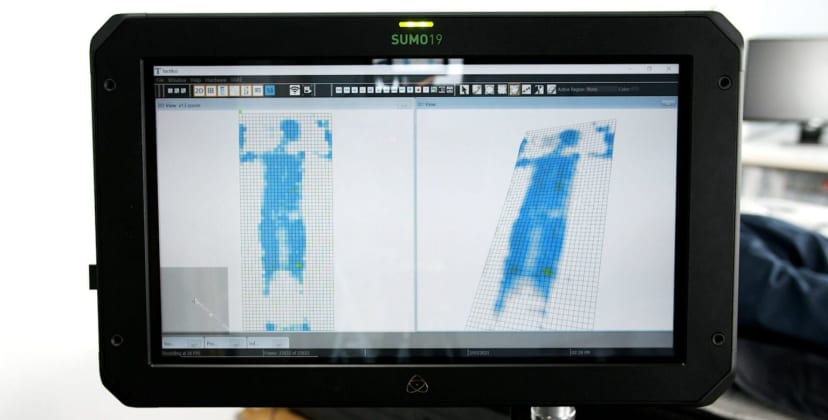
Credit: Sleep Foundation Test Lab
Price
$1,624
Mattress Type
Hybrid
Firmness Options
Medium (5), Medium Firm (6), Firm (8)
Trial Period
120 nights (30-night requirement), $99 return pickup fee
At a Glance
- Who It’s Best For: Back sleepers (medium firm or firm models), with the firmest providing more support for individuals over 130 pounds.
- Feel: Medium (5), medium firm (6), and firm (8). Cushioning yet supportive.
- What It’s Made Of: Organic cotton cover and a thick comfort section containing a 2-inch quilted Euro-top and three layers of polyfoam. Top polyfoam layer , an 8-inch layer of pocketed coils, with firmer coils in the lumbar area and around the perimeter.
- What We Don’t Like: Won’t fit most standard fitted sheets. Firm version may transfer motion.
Scoring & Reviews
The following ratings show how suitable this mattress is for different sleeping positions and sleeper weights. These scores are determined by how well the mattress supports and relieves pressure for each sleeper type.
We performed a meta-analysis on 897 validated customer reviews of the Nolah Evolution 15. This is what people who bought the mattress had to say:- Motion Isolation: Couples note the excellent motion isolation, which minimizes disruptions from partner movements during the night.
- Edge Support: The edge support of the mattress is frequently highlighted, with many finding it adequate for sitting or sleeping near the edge without feeling like they will roll off.
- Softness: Many reviewers discuss the softness of the mattress. Some find it too soft, causing discomfort, especially for heavier individuals, while others appreciate the plushness.
- Pressure Relief and Support: Reviewers frequently highlight relief from back and shoulder pain, attributing this to the supportive foam layers and zoned coil system.
- Heat Retention: A few reviewers note that the mattress retains heat, making it uncomfortable for some, particularly in warmer climates or for those who sleep hot.
- Durability and Quality: Users often comment on the high quality and durability of the mattress, noting that it maintains its shape and comfort over time.
Best Mattress for Couples
Bear Elite Hybrid
8.5 /10
Test Lab Score
40% sitewide with code: SF40
40% sitewide with code: SF40
Memory foam and individually wrapped coils in the Bear Elite Hybrid keep motion from traveling across the bed for back sleepers who sleep with a partner. This mattress also has fairly reliable edges, so each person can spread out and use the whole bed without feeling like they are falling off.
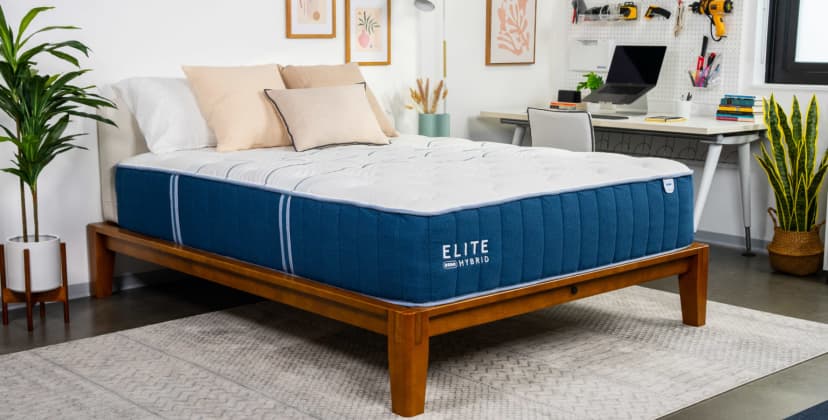
Credit: Sleep Foundation Test Lab
Price
$1,499
Mattress Type
Hybrid
Firmness Options
Medium (5), Medium Firm (6), Firm (8)
Trial Period
120 nights (30-night break-in period)
At a Glance
- Who It’s Best For: Couples who sleep on their back or side.
- Feel: Medium (5), medium firm (6), and firm (8). Has a signature memory foam “hug” that’s tempered by the bounce of the pocketed coils.
- What It’s Made Of: Quilted cover with cooling phase change material and Celliant fibers, followed by a layer of copper-infused memory foam. One more layer of polyfoam and a pocketed coil support core with zoned spinal alignment and perimeter reinforcement.
- What We Don’t Like: Requires deep pocket sheets. Not firm enough for most stomach sleepers.
Scoring & Reviews
The following ratings show how suitable this mattress is for different sleeping positions and sleeper weights. These scores are determined by how well the mattress supports and relieves pressure for each sleeper type.
We performed a meta-analysis on 3703 validated customer reviews of the Bear Elite Hybrid. This is what people who bought the mattress had to say:- Comfort and Support: Many reviewers highlight the mattress’s balance of comfort and support, often mentioning relief from back pain and improved sleep quality.
- Firmness Options: Customers appreciate the various firmness options, with some opting for firmer versions after experiencing discomfort with medium firmness.
- Temperature Regulation: Several reviews note the mattress’s ability to stay cool, which enhances sleep quality, especially in hot weather.
- Size and Upgrade Options: Customers are pleased with the availability of different sizes and the option to upgrade, which provides flexibility for different needs and preferences.
- Quality of Additional Products: Positive remarks on the quality of accompanying products like pillows and sheets, which are often included as free additions.
- Motion Isolation: Many reviewers highlight the mattress’s excellent motion isolation, making it ideal for shared sleeping arrangements.
Best Firm Mattress
Plank Firm Luxe
8.2 /10
Test Lab Score
25% off sitewide with code: WINTER25
25% off sitewide with code: WINTER25
This flippable mattress has two feels: firm and firmer, making it an attractive proposal for back sleepers who don’t like the feeling of sinking into their bed. Both sides of the Plank Firm Luxe also rate well on core features such as temperature control, edge support, and ease of movement.
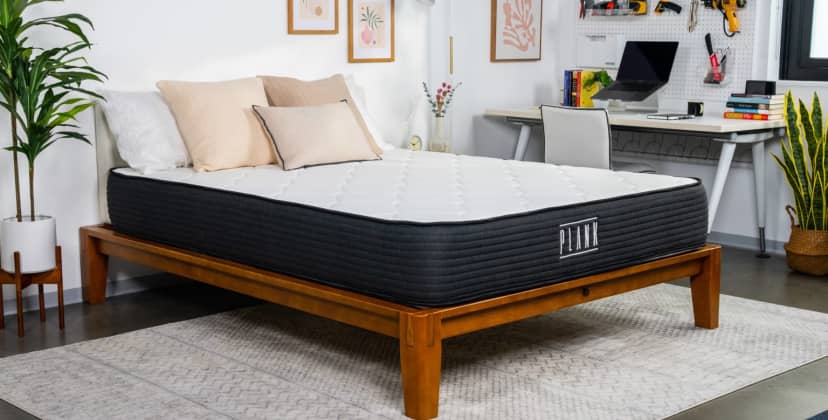
Credit: Sleep Foundation Test Lab
Price
$1,149
Mattress Type
Hybrid
Firmness Options
Firm (7), Extra Firm (9)
Trial Period
120 nights (30-night requirement)
At a Glance
- Who It’s Best For: Back sleepers of all weight categories (regular firm side) and back sleepers over 230 pounds (extra firm side).
- Feel: One side is firm (7), with a somewhat classic responsive feel and light cushioning. The other side is extra firm (9), one of the firmest sleep surfaces we’ve seen.
- What It’s Made Of: Both sides share a core of pocketed coils. The extra firm side has a tight stitching pattern and 2 inches of firm polyfoam. The firm side offers a little more give, with a thin quilted layer and two layers of foams that are a little plusher.
- What We Don’t Like: No “hug” feeling. Couples may feel motion transfer. Return fee of $99.
Scoring & Reviews
The following ratings show how suitable this mattress is for different sleeping positions and sleeper weights. These scores are determined by how well the mattress supports and relieves pressure for each sleeper type.
We performed a meta-analysis on 1748 validated customer reviews of the Plank Firm Luxe. This is what people who bought the mattress had to say:- Comfort and firmness: Many reviewers discuss the comfort level of the mattress, often highlighting its firm feel. While all of those bought the mattress for its firmness, a few people still found the bed too firm.
- Cooling features: Several reviewers mention the cooling features of the mattress, specifically the Glaciotex Cooling Cover, which is appreciated for providing a cooler sleep experience.
- Pain relief: A recurring theme is the relief from back and joint pain, with many users noting improvements in their sleep quality and reduction in pain. Many users report improved spinal alignment, especially those who prefer firmer mattresses.
- Dual firmness options: The mattress’s ability to be flipped for different firmness levels (firm and extra firm) is frequently mentioned and appreciated by those who have different firmness preferences.
- Edge support: A lot of reviewers mention the strong edge support of the Plank Firm Luxe.
- Off-gassing: A few reviewers note the presence of off-gassing when the mattress is new, but it typically dissipates after a few days.
- Customer service: Experiences with customer service are generally positive, with reviewers appreciating the responsive and helpful support team. The 120-night trial period and responsive customer service are frequently noted as key advantages.
Best Organic Mattress
Birch Mattress
8.8 /10
Test Lab Score
25% off sitewide with code WKFLSH25
25% off sitewide with code WKFLSH25
Most people associate pressure relief with plush cushioning, but spinal support is just as important when it comes to preventing pressure buildup. The Birch Mattress offers loose contouring to take away sharp pressure points, while also offering a reliable framework to keep the spine on an even plane.
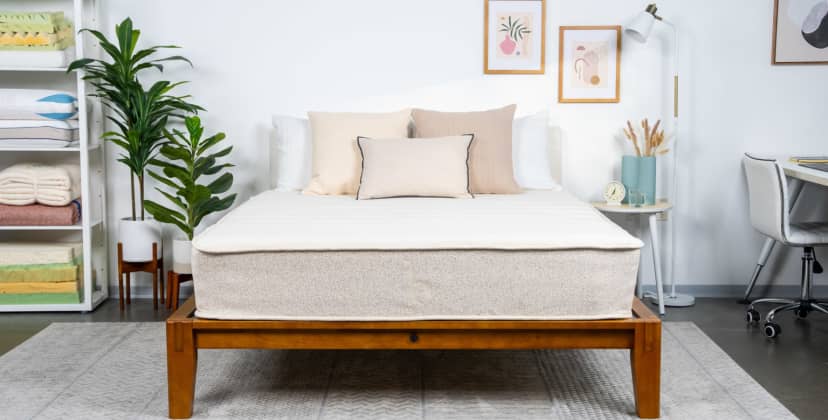
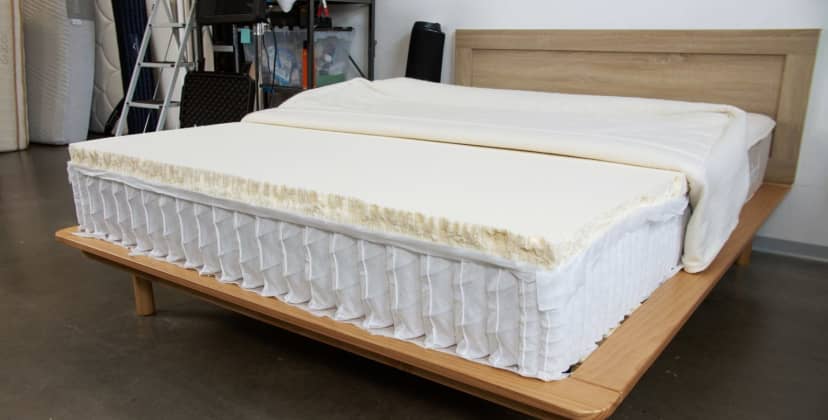

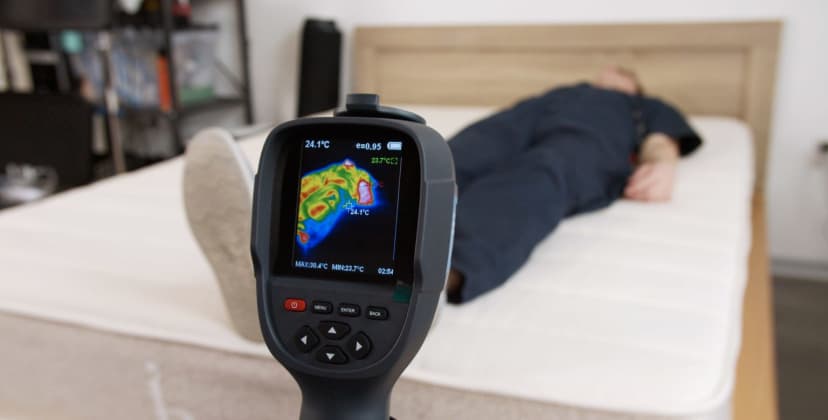
Credit: Sleep Foundation Test Lab
Price
$1,499
Mattress Type
Latex Hybrid
Firmness Options
Medium Firm (6)
Trial Period
120 nights (30-night requirement)
Full Details
- Who It’s Best For
- Side, back, and stomach sleepers over 130 pounds, as well as eco-conscious shoppers and hot sleepers.
- Feel: Medium firm (6). Light and springy, cloud-like feel. Cushioning without feeling stuck in the bed.
- What It’s Made Of: Organic wool padding, a layer of aerated natural latex, and a pocketed coil support core with reinforced sides boosts spinal support. Organic cotton cover and an organic wool base.
- What We Don’t Like: Too firm for those under 130 pounds. Return fee of $99.
Scoring & Reviews
The following ratings show how suitable this mattress is for different sleeping positions and sleeper weights. These scores are determined by how well the mattress supports and relieves pressure for each sleeper type.
We performed a meta-analysis on 1917 validated customer reviews of the Birch Mattress. This is what people who bought the mattress had to say:- Comfort and Support: Many reviewers mention the mattress provides excellent support and comfort, particularly noting improvements in back and shoulder pain.
- Dual Firmness: The flippable design offering a choice between firm and soft sides is frequently appreciated, allowing users to customize their sleeping experience.
- Durability and Quality: Customers commend the high-quality, eco-friendly materials and construction, expressing satisfaction with the mattress’s durability and longevity. The use of organic and natural materials not only ensures comfort but also contributes to the mattress’s overall durability.
- Temperature Regulation: Customers appreciate the mattress’s ability to maintain a comfortable sleep temperature, attributing this to its natural and organic materials. The use of organic wool and natural latex contributes to effective temperature regulation, enhancing overall sleep quality. .
- Price: Opinions on the mattress’s price vary, with some finding it a good value and others considering it somewhat expensive.
- Weight and Maneuverability: The mattress is noted to be heavy, making it difficult to move or flip without assistance.
- Smell and Off-gassing: A few reviewers mention an initial off-gassing smell that dissipates over time.
- Edge Support: Mixed reviews on edge support, with some some noting it could be improved.
The Best Deals of the Week
-
Save $199
—
Brooklyn Bedding CopperFlex Memory Foam
$466 (List Price $665) -
Save $600
—
Helix Midnight Luxe
$1,799 (List Price $2,399) -
Save $2,436
—
Nectar Adjustable Bundle
$1,398 (List Price $3,834) -
Save $771
—
WinkBed
$1,799 (List Price $2,570) -
Save $1,020
—
DreamCloud Classic Hybrid
$699 (List Price $1,719)
Best Mattress Overall
Luxury Firm WinkBed
9.5 /10
Test Lab Score
Get $300 off all mattresses at Winkbeds
Shop NowA robust hybrid mattress with targeted lumbar support for back sleepers.
See More Details
Most Comfortable Mattress
Helix Dusk Luxe
9.7 /10
Test Lab Score
25% off sitewide with code WKFLSH25
Shop NowA balanced hybrid mattress that caters to back and stomach sleepers.
See More Details
Best Value Mattress
Nectar Adjustable Bundle
8.5 /10
Test Lab Score
Save up to 50% on mattresses + 15% off regular prices
Shop NowA one-stop shopping solution for back sleepers on a budget.
See More Details

Best Luxury Mattress
Saatva Classic
9.5 /10
Test Lab Score
$300 off orders of $1,000 or more
Shop NowA supportive and responsive mattress for back sleepers that’s inspired by the classic innerspring.
See More Details
Best Cooling Mattress
Brooklyn Bedding Aurora Luxe
9.2 /10
Test Lab Score
25% off sitewide with code: WINTER25
Shop NowA hybrid mattress packed with sophisticated cooling features for back sleepers who sleep hot.
See More Details
Best Mattress for Spinal Alignment
Nolah Evolution 15
9.2 /10
Test Lab Score
35% off sitewide + extra $100 off with code: SF100
Shop NowMulti-layer zoning promotes healthy posture when back sleeping.
See More Details
Best Mattress for Couples
Bear Elite Hybrid
8.5 /10
Test Lab Score
40% sitewide with code: SF40
Shop NowA memory foam hybrid that virtually eliminates motion transfer for back sleepers who share the bed.
See More Details
Best Firm Mattress
Plank Firm Luxe
8.2 /10
Test Lab Score
25% off sitewide with code: WINTER25
Shop NowA two-sided mattress that offers firm support for back sleepers.
See More Details
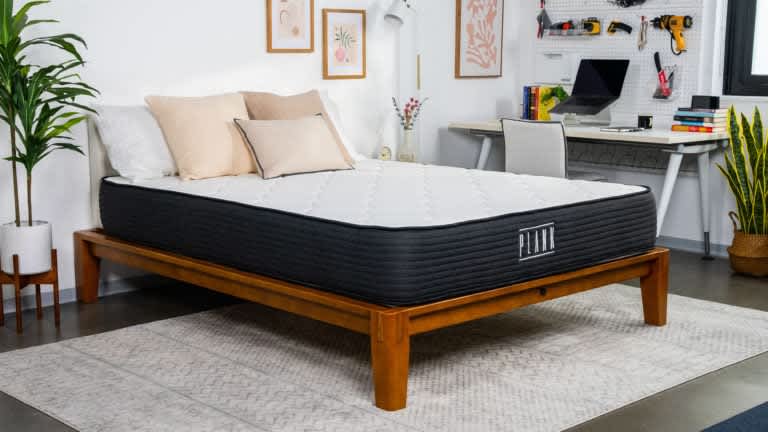
Credit: Sleep Foundation Test Lab
Best Organic Mattress
Birch Mattress
8.8 /10
Test Lab Score
25% off sitewide with code WKFLSH25
Shop NowTalalay latex and coils provide a lofty yet supportive feel for back sleepers.
See More Details
What to Consider as a Back Sleeper
“Sleep position is important to consider because it can significantly impact your overall health, comfort and sleep quality,” says Sleep Medicine Physician Lulu Guo, M.D. “Different sleep positions have unique needs when it comes to mattresses and accessories to ensure proper support, comfort and alignment.”
Dr. Guo goes on to say choosing the right firmness is crucial for any sleep position. “For back sleepers,” she says, “medium firm mattresses may be the most ideal as they provide enough support for spinal alignment while offering some cushioning for comfort. Whereas for side sleepers, a softer mattress may work well to provide cushioning for the shoulders and hips while still providing support. Lastly, firmer mattresses may be most suitable for stomach sleepers to prevent the hip from sinking too low causing misalignment of the spine.”
Spine Alignment
Spinal alignment refers to how well the spine lines up to its natural shape. Maintaining good spinal alignment overnight can help reduce aches and pains, contributing to a better night’s sleep. Because of this, the University of Rochester Medical Center suggests that regardless of sleep position, sleepers should try to line up their ears, shoulders, and hips to maintain proper spinal alignment.
One benefit of back sleeping is that your body is naturally centered over your spine.This makes it easier to maintain proper spinal alignment, as long as your mattress provides enough support to the shoulders and mid-section to prevent them from sinking too deeply. Back sleeping may also reduce the risk of developing wrinkles or breakouts on your skin and can alleviate lower back pain for some sleepers.
Sleep Apnea and Other Conditions
While back sleeping has some clear benefits, it isn’t ideal for all sleepers. Those who suffer from sleep apnea or are prone to snoring may find their conditions aggravated by sleeping on their backs. People with acid reflux or gastroesophageal reflux disease (GERD) may also notice increased symptoms when sleeping on their backs, especially for sleepers with extra weight in their midsections that adds pressure in that area.
Predominant side sleeping, more specifically left sided sleeping, is recommended for the second and third trimesters of pregnancy. Pregnant women often find that sleeping on their backs can contribute to back pain due to the extra weight in their midsections. Laying on the back can also compress a major vein which can decrease blood flow to the fetus and the mother’s organs.
Back Sleepers With Back, Neck, and Shoulder Pain
Improper alignment can contribute to aches and pains. If your mattress doesn’t have the right balance of contouring and support, your muscles may work overtime to try to improve your body’s alignment. Since these muscles can’t fully relax, you may wake up with more aches and pains. If you do experience aches and pains in the morning, it may be worth looking at a new mattress.
How to Choose a Mattress for Back Sleepers
While many mattress companies claim their models are comfortable for all sleep positions, back sleepers have unique needs. Focusing on the most important mattress features can help you find a mattress that supports your spine while cushioning your pressure points. Below, we’ll detail key factors to consider when selecting the best mattress for back sleepers.
Firmness and Support
A mattress’s firmness influences how much the sleeper sinks in, how comfortable the mattress feels, and how supportive it is for certain body types. A 10-point firmness scale is commonly used to rate mattress firmness. In this scale, 1 is the softest mattress and 10 is the firmest.
Back sleepers often favor slightly firmer mattresses than their side-sleeping counterparts. This is because back sleepers require more support to maintain the natural alignment of their spines, but they don’t experience the same types of pressure points that side sleepers often do. Too soft of a mattress may cause a back sleeper’s hips to sink in too far, while too firm of a mattress may not allow their hips to sink in far enough. “Long term consequences of this causes misalignment of the spine and can cause low back pain,” adds Dr. Guo.
Body Weight
The right firmness level for you depends in large part on your body type. Most individuals between 130 and 230 pounds prefer a medium or medium firm mattress. Average-weight back sleepers usually gravitate towards the firmer end of this range since they don’t require as much conforming as side sleepers.
Sleepers who weigh under 130 pounds don’t apply as much force on a mattress, so any mattress is likely to feel firmer to them. Because of this, back sleepers in this range often prefer a medium or medium soft model.
Individuals who weigh over 230 pounds need more support than other weight groups. Too soft of a mattress may cause their hips to sink in excessively, misaligning the spine. These sleepers frequently favor a medium firm or firm mattress to give them extra support.
Contouring
Many mattresses contour to the body, adjusting to each sleeper’s unique shape. This can help support a back sleeper’s spinal alignment while relieving pressure points. Mattresses vary in how much contouring they provide, with softer mattresses and those containing foam offering the most. Back sleepers typically prefer a moderate level of contouring to fill in the space around their lower backs while not allowing for too much sinking.
Pressure Relief
Pressure relief is closely linked to contouring. When a mattress contours to a sleeper’s body, it distributes their weight more evenly. This can take the pressure off heavier body parts, like the hips and shoulders. While back sleepers don’t usually suffer from sharp pressure points like side sleepers, they may still appreciate a mattress that cradles their hips.
Quality Materials
Quality materials can impact how comfortable a mattress feels and how well it holds up over time. Mattress sagging is often a problem for back sleepers, and high-quality materials frequently resist sagging better than lower-quality alternatives.
Which Type of Mattress Is Best for Back Sleepers?
While individual models may have notable differences based on their materials, quality, and construction, there tend to be some similarities between models of the same type of mattress. Understanding the key benefits and features that are common for each type of mattress may clarify which type is best for you.
Hybrid
Hybrid models have a thick comfort layer of memory foam, polyfoam, or latex, though it may also contain wool, microcoils, or other materials. The support core uses pocket coils, which move independently of one another and minimize motion transfer, unlike those typically found in innerspring mattresses.
A hybrid’s balance of contouring and support make it a good fit for back sleepers. The generous comfort layer is engineered to conform to the sleeper’s body for pressure relief and the coil support core gives solid, even support, which can help promote proper spinal alignment for back sleepers
Innerspring
A substantial support core of coils serves as the main component of an innerspring mattress, and they may also have thin comfort layers. While these comfort layers may provide some cushioning, they’re usually not substantial enough for contouring and pressure relief.
High-quality innerspring mattresses usually have even support that can help keep a back sleeper’s spine straight. Thin comfort layers may cushion the sleeper’s pressure points, but they generally are not thick enough to allow a back sleeper’s midsection to sink in too deeply.
Latex
Latex mattresses are traditionally constructed of multiple layers of latex foam, which may be natural, synthetic, or a blend. Talalay latex is usually lighter and springier and is commonly used in comfort layers. Dunlop latex is generally denser and more durable, making it a popular choice for both comfort and support layers.
While memory foam compresses directly beneath the sleeper’s body, latex spreads the compression over a wider area. This cradles the sleeper without excessive sinkage, creating a balance between cradling and support that may make back sleepers feel like they are floating on the bed.
Airbed
Airbeds get their name from the air chambers they use to support the sleeper. Depending on the model, these air chambers can be emptied or filled using a pump, remote control, or app. Airbeds may also include comfort layers, though these are usually relatively thin. Comfort layer materials may include memory foam, polyfoam, latex, wool, and/or cotton.
Since the air chambers can be filled or emptied to change the feel of the mattress, back sleepers can adjust an airbed to get as close as possible to their ideal firmness. Some models also allow sleepers to adjust each side of the bed independently, which may make them a good choice for partners who have different firmness preferences.
Foam
Most foam mattresses are constructed of multiple foam layers, which usually include memory foam, polyfoam, or a combination of the two. Softer foams are traditionally used in the comfort layers to contour to the sleeper, while firmer support foams prevent them from sinking in too deeply.
All-foam models tend to shape to the sleeper’s body, providing a close hug that relieves pressure points. Firmer models give less hug, but they still usually contour enough for pressure relief. Back sleepers who like to sink into their mattress may appreciate this close conforming. “Firmer foam mattresses may have the dual benefit of conforming to the body yet have enough support for back sleepers for spine alignment,” says Dr. Guo.
Important Accessories for Sleeping on Your Back
Accessories can be the finishing touch to make your sleep surface more comfortable. While you might upgrade your accessories when you purchase a new mattress, sleepers on a budget may look to them as a lower-cost alternative to replacing their mattress.
Pillows
While the right mattress can keep most of the spine aligned, your pillow is responsible for continuing that alignment into the neck and head. The wrong pillow can contribute to back and neck pain.
Pillow loft refers to how thick a pillow is. A pillow with too much loft may force a back sleeper’s head towards their chest. A pillow with too little loft may hyperextend the neck. The best pillows for back sleepers are medium-loft pillows that support the head, neck, and shoulders without lifting them up too far. Back sleepers often prefer memory foam or latex pillows that cradle the head to help them maintain proper alignment.
While many back sleepers favor a medium-loft pillow, those with medical conditions aggravated by lying flat may prefer a wedge pillow to elevate the upper body. Sleepers who suffer from sleep apnea, acid reflux, or frequent snoring may also benefit from this extra lift.
| Sleeping Position | Pillow Loft Recommended |
|---|---|
| Back | Medium |
| Side | Medium or High |
| Stomach | Low |
Many back sleepers also place a small pillow beneath their knees. “Placing a pillow under the knees can help with spinal alignment because, when laying flat, the lower back can arch excessively,” says Dr. Guo. “A pillow under the knees elevates the legs slightly, reducing this arch and keeping the spine in a more neutral position. Elevating the legs can also take pressure off the lower back, further promoting more relaxation during sleep.”
Mattress Toppers
A mattress topper is an extra layer that rests on top of the mattress to adjust the feel of the surface. While a mattress topper won’t completely overhaul your existing mattress, it may make it more comfortable.
Because mattress toppers are usually less expensive than purchasing a new mattress, they can be a convenient and affordable way to modify the sleep surface and try out different materials. Memory foam, polyfoam, and latex toppers can give you an idea of how a mattress that uses these materials might feel without the commitment of replacing your existing mattress.
While mattress toppers can add some cushioning and contouring, they don’t provide all the benefits of a new mattress. Most notably, they don’t usually provide significant support. If your hips are sinking in too deeply in your existing mattress, a mattress topper is unlikely to resolve the issue. A mattress topper also won’t make up for a mattress that is in bad condition or is sagging. However, a mattress topper may be a good choice for back sleepers who feel their mattress is a little too firm or who are experiencing pressure points.
How We Test: Your Comfort Is Our Science
Our industry-leading product testing team cares deeply about improving your sleep. Having a holistic understanding of a mattress’s role as part of a sleep system is paramount to our testing process. Since a bed’s comfort and feel depend largely on body weight and sleeping position, our testing team represents a wide range of body types, sleep positions, and comfort preferences.
In our Seattle-based Test Lab, we use an objective, hands-on process to evaluate mattresses across performance categories. The following are the key guidelines that inform our performance ratings. Our ultimate goal is to ensure you have all the information you need to make the best purchase decision for you.
Construction analysis: Mattress construction plays a major role in our ratings system. We begin our testing with a top-to-bottom analysis of each mattress, making note of its materials, firmness, thickness, and other physical attributes. Price-point is another major factor as we assess quality of materials and overall value.
Quantitative product testing: For hands-on testing, our team members take turns lying and moving on each mattress. This immersive process helps us evaluate beds for performance categories like motion isolation, pressure relief, ease of movement, and temperature control.
Field testing: Once we’re finished testing a mattress in our lab, one of our team members takes it home and sleeps on it in their own bedroom for two to three weeks. Field testing helps us understand how each mattress performs in the long term.
User feedback: In addition to our team’s testing data, we draw from customer surveys and product reviews to calculate our final ratings. This helps us ensure our findings are consistent with real-world experiences.
How We Determine Our Overall Scores


To determine a mattress’s overall score, we assign weighted percentages to performance categories based on how important they are to the individual sleep experience. For instance, areas like pressure relief and temperature control tend to matter more to people than something like off-gassing, and because more people sleep on their side and back than on their stomach, we weigh those positions more heavily
Performance Categories
Motion Isolation
This criteria alludes to the amount of motion a mattress absorbs when a sleeper moves on the surface. We use two testers lying side by side to evaluate motion isolation, who each feel for transfer while the other person moves on the mattress.
Temperature Control
To determine how well a mattress regulates temperature, we perform temperature tests and look closely at its materials and construction. Many mattresses are designed with cooling components meant to reduce heat retention.
Pressure Relief
A bed with strong pressure relief excels at preventing pressure from building up in areas like the shoulders and hips. Beds with even contouring and weight distribution are top performers when it comes to pressure relief.
Off-Gassing
A mattress in a box may release unpleasant chemical odors for a short period after you’ve unboxed it. The initial smell may be strong but typically fades within 2 or 3 days.
Ease of Movement
This criteria reflects how easily a sleeper can move across a bed’s surface. Responsive surfaces made of latex typically perform better than foam surfaces, which can inhibit movement.
Edge Support
We perform sit tests along a bed’s perimeter to measure how well the edges push back against weight. Mattresses with strong edge support have minimal sagging when sleepers sit on or lie close to the perimeter.
Dive Deeper – Mattress Guides by Sleeper Type
If you want to expand your options beyond beds for back sleepers, you can read through our collection of mattress guides categorized by sleeping preferences.
Best Mattress by Sleeper Type
- Best Mattress for Athletes
- Best Mattress for Couples
- Best Mattress for Kids
- Best Mattress for Toddlers
- Best Mattress for Seniors
- Best Mattress for Teenagers
- Best Cooling Mattress for Hot Sleepers
- Best Tempur-Pedic Mattress for Side Sleepers
- Best Tempur-Pedic Mattress for Back Sleepers
- Best Tempur-Pedic Mattress for Stomach Sleepers
Frequently Asked Questions
What firmness level is best for back sleepers?
A medium firm (6) mattress is best for back sleepers. This firmness level provides a nice, even surface to keep a back sleeper’s spine aligned with just enough cushioning to ease any tension in the lower back. Mattress firmness is somewhat subjective and also depends on your body type, so you may find that you need a slightly firmer mattress if you weigh more than 230 pounds and a slightly softer one if you weigh less than 130 pounds.
What type of mattress is best for back sleepers?
While back sleepers can find comfort on a variety of mattress types, a medium firm hybrid is often a good fit. Because of the combination of supportive coils and a conforming comfort layer, a hybrid tends to offer the right balance for back sleepers. If you have a larger budget, you could also consider a latex mattress, which offers good contouring without the hug of a foam mattress.
Is back sleeping worse for sleep apnea?
The symptoms of sleep apnea can worsen when you’re sleeping on your back because gravity can cause your tongue to fall back in your throat, partially blocking your airway. Many doctors will advise you to sleep on your side if you have sleep apnea. It’s worth noting that if you have moderate to severe sleep apnea, changing your sleeping position is unlikely to make your symptoms go away, and it’s important to talk to your doctor.

Still have questions?
Our product experts have extensive experience testing just about every sleep product on the market.
Send an email to AskAnExpert@sleepfoundation.org with your questions and we’ll help you find exactly what you’re looking for.
